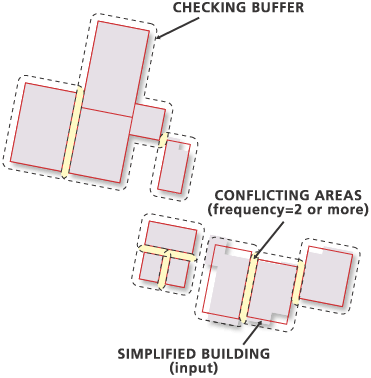Available with Advanced license.
Summary
Finds where simplified buildings overlap or are too close to each other, based on a specified distance.
Illustration

Usage
Finding conflicts among simplified buildings is a part of the postprocessing of the Simplify Building tool. Therefore, the input coverage must have buildings as regions created by the Simplify Building tool followed by the Clean tool with the POLY option.
This tool will help you locate where buildings are within the specified distance. A buffer will be created around each building or group of connected buildings. Overlapping buffers indicate a conflict. An item, FREQUENCY, will be added to the out_cover.PAT, carrying the number of buffers that share each polygon. A FREQUENCY value of 1 means no conflict; a value of 2 or more, according to how many buffers overlap, indicates a conflict area. Buildings connected in one group are not considered conflicting with each other. Only the outer boundary of such a group will be checked with neighboring buildings or groups of buildings.
The output coverage is created only if conflicts are identified. Since the input buildings are regions, the buffers in the output coverage are also regions with a subclass BUF. You can select and view the conflict areas (the polygons with a FREQUENCY value of 2 or more) and make necessary edits.
Syntax
FindConflicts(in_cover, out_cover, conflict_distance)
| Parameter | Explanation | Data Type |
in_cover | The input coverage containing buildings as regions, with the subclass BLDGSIM and the item BDS-GROUP, obtained by the Simplify Building tool followed by the Clean tool with the POLY option. | Coverage |
out_cover | The output coverage containing overlapping region buffers, with a subclass BUF, that show spatial conflicts among buildings. This coverage will only be created when conflicts are found. The <out_cover> name must be different from the <in_cover> name. | Coverage |
conflict_distance | Sets the conflict distance in coverage units. Buildings within this distance are considered in spatial conflict. The distance must be greater than 0. | Double |
Code sample
FindConflicts example (stand-alone script)
The following stand-alone script demonstrates how to use the FindConflicts tool.
# Name: SimplifyBuilding_Example.py
# Description: Simplifies a building coverage and finds conflicts in the output
# Requirements: ArcInfo Workstation
# Import system modules
import arcpy
from arcpy import env
# Set environment settings
env.workspace = "C:/data"
# Set local variables for SimplifyBuilding
inSimplifyCover = "campus"
outSimplifyCover = "C:/output/tempcampus"
simplificationTolerance = 6
minimumArea = 55
# Set local variables for FindConflicts
inCover = outSimplifyCover
outCover = "C:/output/cartocampus"
conflictDistance = 5.5
# Execute SimplifyBuilding and Clean
arcpy.SimplifyBuilding_arc(inSimplifyCover, outSimplifyCover,
simplificationTolerance, minimumArea, "", "")
arcpy.Clean_arc(outSimplifyCover)
# Execute FindConflicts
arcpy.FindConflicts_arc(inCover, outCover, conflictDistance)
Environments
Licensing information
- Basic: No
- Standard: No
- Advanced: Requires ArcInfo Workstation installed